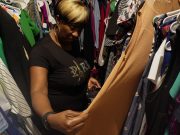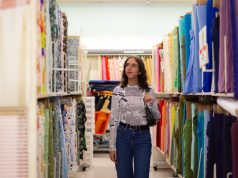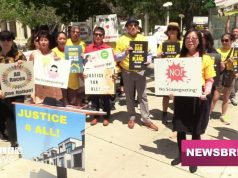Miami is one of only a handful of major U.S. cities with a majority-Latino population. It’s 69 percent of the population here, according to U.S. Census. The city also boasts an abundance of Spanish-language content produced by TV stations such as Telemundo and Univision. This is a culturally unique corner of the country, a place many describe as the “Miami bubble.” Latinos who leave the city often discover they are misrepresented or underrepresented in mainstream media.
Sabrina Diehl, an actress attending the University of Minnesota, said that when she moved there from Miami, she felt like an outsider. She experienced being seen as a minority for the first time. “I feel very lucky that I grew up in Miami because, in Miami, Latino people are the majority,” she said. “You don’t grow up thinking that you’re ever going to have any limits, that people aren’t going to give you a job based on the way you talk or look.” She added that if she hadn’t grown up in Miami, she might not be pursuing acting at all because of the increased barriers to success that often affect minorities.
Sabina Arcila, a Miami Latina and aspiring playwright and actress who attends New World School of the Arts, isn’t bothered by the dominance of Anglo culture on TV, in movies, and in the government. She said that it is balanced by content from Telemundo, Univision, and Caracol, and noted that her government representatives are of Latino descent. Arcila feels grateful and privileged to have grown up in Miami, where most of her friends are like her and her culture isn’t seen as a burden.
“You don’t really feel the full weight of what it is to be Latinx in the U.S. until you go somewhere else,” said Arcila. “You realize the only people who are like you work in the kitchen.” Traveling outside of Miami opened her eyes to what Latinos in other parts of the country experience and helped her understand the repercussions of being underrepresented in media and government.
Latinos are the second-largest minority group in the United States, making up 18.3 percent of the country’s population, according to the U.S Census, but they are not proportionally represented in media. There has been much public outcry over this lack of inclusion; most recently the 2019 Emmy Awards came under fire for their lack of diversity. There were only 24 acting nominations for people of color, a decrease from last year’s 38. A total of three people of color won awards in hosting and major acting categories this year.
Latinos are also underrepresented off-screen. Fewer than 1 of 10 film writers are people of color, according to UCLA’S 2019 Hollywood Diversity Report. Arcila expressed dismay, but not surprise, at how difficult it is to find monologues – speeches by an actor in a play or movie – written by Latino artists in her field.
Arcila has written one play with Ismael Salcedo Alarcon, a senior at New World School of the Arts who is pursuing acting and playwriting. He attributed Latino underrepresentation in media to factors such as accents when speaking English. “I remember freshman year when I first got into New World and I saw all my peers act, and I had to present,” said Salcedo Alarcon. “I was very insecure because I had just come from Mexico and my accent was thicker than now.” Now that he is applying for colleges, he still wonders, “What if they don’t like me because of my accent?”
Salcedo Alarcon also suspects that skin color plays a factor in what types of roles are available to Latinos, saying that films can be biased towards a certain look. But he remains optimistic that the tide is turning; audiences want more diversity and films are becoming more open to casting Latinos and African Americans.
“People need to be represented because who’s going to tell their story? When we tell these stories and we let people connect with Hispanics, people are going to understand our point of view,” he said.
Diehl said she connected with the show One Day At a Time because it tells her story. “It’s about a Cuban family with a single mom, an older sister and a younger brother. Watching that show was like watching myself and my life on screen. I had never experienced that before,” she said.
Nancy Tellet, chair of the research committee for the Culture Marketing Council, a trade group, said that in a study conducted in 2018, 78 percent of Hispanics aged 13 to 17 said they watched TV shows with diverse casts like Jane the Virgin for reasons such as, “I personally relate to a diverse cast” and “It feels more like real life because in real life it is diverse, and you don’t see that represented.”
“I remember one girl talking about how she felt when she watched TV or movies, she didn’t feel represented and, if she did, it wasn’t in a positive way,” said Tellet. “We heard stories along those lines that seeing yourself represented and seeing it done right was a big deal.”
West Side Story, a 1961 movie adaptation of a musical that depicts a Puerto Rican community in New York City, was a mainstream success that inaccurately represented Puerto Ricans, said Diehl. “Puerto Ricans hate West Side Story,” she said. “It can be portrayed as very racist. For a long time, Latinos haven’t been represented in the media and, when they have, it hasn’t been in a good light.” Diehl emphasized the importance of including Latino writers in productions as they are the ones who will determine how Latinos characters and communities are portrayed.
“Growing up as a minority, you feel like you’re the only one with this story because it’s different than what you see in the media,” said Arcila. “I feel like once you have artists who are from your community and making work, they validate your experience and your identity. They allow you to be proud of who you are and where you come from.”

































